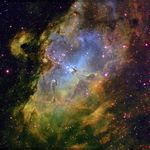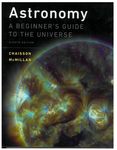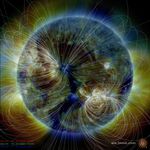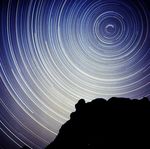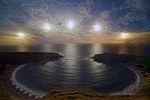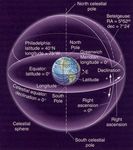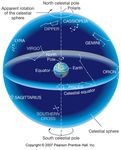Astronomy AST-1002 Section 12147 Discover the Universe Spring 2020
←
→
Page content transcription
If your browser does not render page correctly, please read the page content below
Astronomy AST-1002
Section 12147)
Discover the Universe
Spring 2020
Instructor: Dr. Francisco Reyes
Web Page:
http://www.astro.ufl.edu/~freyes/classes/ast1002/index.htm
Textbook:
“Astronomy: A Beginner’s Guide to the Universe”
Chaisson and McMillan, 8th Edition. E-version with access
to My Lab and Mastering AstronomyInstructor: Dr. Francisco Reyes
Office: 12 Bryant Space Science Center (Building 38)
Phone: (352) 294-1885
Email :freyes@astro.ufl.edu
Class web page:
www.astro.ufl.edu/~freyes/classes/ast1002/index.htm
In this web page you will find the syllabus, copies of Power Point
presentations, form and instructions for the Observing Project,
scores and other class material.
We will be switching to Canvas during the semester
Office hours: Tuesday 12:00 -1:00 PM, Thursday 2:00-3:00 PM (Or
by appointment)The textbook We will be using “Mastering Astronomy” Purchase the e-copy with access to “MyLab and Mastering Astronomy” You will need the access to these to answer the homework If you have problems registering and accessing the All-Access and Opt In, see the Pearson representative this Thursday at the UF Bookstore
Astronomy is an amazing and interesting field!
Let’s take a look to some recent news and discoveries
Images of the Total Solar Eclipse August 21, 2017
Images and sequence courtesy of Dr. Naibi Marinas, UF Astronomy Dept.
A sequence of the phases
of the eclipse
Solar CoronaImages of the Sun from 08/26/2015
Magnetic field configuration
Visual image showing (Solar Dynamic Observatory, UV image)
sunspot 2403A few recent news and discoveries: Comets An image of the nucleus of Comet 67P taken by the Rosetta spacecraft on August, 2015. The image was taken when the comet was near the closest Comet Siding Spring C/2013 passing close to distance from the Sun. Mars (132,000 km from its surface) on October These are the first high resolution 19, 2014! images of jets of gas ejected from the It was the first time to see a comet passing so nucleus of a comet! close to a terrestrial planet! The size of the nucleus is about 4 km Mars was at 1.6 AU from Earth
More recent and interesting news
Jets of water vapor in Enceladus (A
satellite of Saturn) imaged by the
Cassini spacecraft. Molecules present
in the jets are water, carbon dioxide,
methane and ammonia
The satellite as a diameter of 500 km
An interesting object to search for
possible life in the solar system
Discovery of an exoplanet
with a mass close the mass of
Earth and orbiting a star inside
the habitable zone. Discovered
by the Kepler spacecraft team.
Reported on April, 2014.
The system Kepler-186 has 5
planets and it is located at 500
light years from EarthMore news on exploration of the Solar System
The search for life in the solar system.
Europa (a satellite of Jupiter). It has an ocean of liquid water
under the frosted crust. The energy to maintain liquid water
comes from dissipation of tidal heat.
This satellite is the target for a mission that may launch
around 2020. The mission will search for organic material
and possible presence of primitive lifeMore news on the exploration of the Solar
System
The search for life in the solar system.
Titan (a satellite of Saturn). It has a thick atmosphere composed of complex
organic molecules (Hydrocarbons).
It has lakes of liquid methane on its surface and an ocean of liquid water
under the frozen surface.
Another interesting body that may harbor some kind of primitive lifeMore news on the exploration of the Solar
System
Curiosity rover landed on Mars
in August 2012. It has been
analyzing and taken images of
the Martian soil.
It landed inside the Gale crater
( now a dry lake). It is
analyzing the soil for possible
presence of organic material
It has found seasonal increase
and decrease of methane gas.
Not sure yet if the gas may
have an organic or geological
originMars south pole: Possible detection of liquid water by the Mars
Express spacecraft using radar echoes (Reported on July, 2018)
The layer of liquid water is located about 1.5 km under the icy
surfaceConfirmation of water ice found on the Moon’s poles
Water ice in the floor of craters (temperature -390 F, 40 K)
Infrared data from India’s Chandrayaan spacecraft reported August 20, 2918
South pole North poleMore news on the exploration of the Solar
System
New Horizon spacecraft: Pluto fly-by
on July 14, 2015. This is the first
spacecraft to reach Pluto. It provided
with the first high resolution images
of Pluto. Average distance from Pluto
to the Sun is about 39.5 AU
New Horizon spacecraft: Ultima
Thule fly by on December 31, 2018-
January 1st, 2019. This object is
located in the Kuiper belt. It is the
farthest object visited by a spacecraft.
Size (length) of object is about 33 km.
Distance from the Sun is about 45 AU
1 AU (Astronomical Unit) =150 million kmDetection of Gravitational Waves
The generation of gravitational waves was predicted by
Einstein is his Theory of General Relativity (1915-1916)
The signal detected by the LIGO
observatories on Sept. 24, 2015
from the merger of two black
holes. The masses of the black
holes are 29 and 36 solar masses.
This is the first direct detection of
gravitational waves.
One of the two LIGO (Laser Interferometer
Gravitational-Wave Observatory)
observatories
One observatory is in Louisiana and the
other in Washington State. Separated by
about 3,000 km (10 ms delay at speed of
light).
Each arm is 4 km long.First image of the shadow of a massive black hole in M87
galaxy. Reported on April 10, 2019
Location of M87 in the Virgo galaxy cluster (Virgo constellation)
Elliptical
galaxy M87
Image of the partial view of the Virgo clusterClose up of M 87 and its jet M 87 is located at 55 million light-years from the Solar System. The super massive black hole located at the center of the galaxy has a mass of 6.5 billion solar mass. The composition of the jet is ionized matter ejected at high speed from outside the black hole (accretion disk) threaded by magnetic fields
M 87 Black Hole shadow
Eight radio observatories combined the data in a technique called VLBI (Very Long Base Interferometry)
to produce the image of the shadow of the black hole. The observation was done at a wavelength of 1.3 mm
The resolution of the VLBI data at 1.3 mm is 20 micro-arcseconds
Shadow of
the black
hole
The event
horizon is
about 2.5
times
smaller than
the shadow
Disk of glowing plasma
(Superheated matter)Chapter 0:
Charting
the
Heavens
Reading assignment: Chapter 0 “Charting the Heavens”Learning outcome
Understand the basic levels of structure of the Universe
Understand how astronomers use the celestial sphere to represent the sky.
What is a constellation? The celestial coordinate system used to locate
objects and the use of angular measurements to locate and find distances
in the celestial sphere
Account for the motions of the Sun, Moon, planets and stars in the celestial
sphere
Understand why the tilt of the rotational axis of Earth is related to the
seasons
Explain the changing appearance of the Moon (lunar phases)
Understand the reasons for having solar and lunar eclipses and what are
the phases of the moon for these two types of eclipses.
Understand the geometric method used to measure distances and sizes to
inaccessible objects.
Distinguish between a scientific theory and a “theory” (or “idea”) used in
common language.We will study our solar system… Stars and star clusters…
We will continue with the
Sun… Pleiades Cluster (Seven Sisters, Subaru)
Nebulae…
Ring Nebula
(Planetary
nebula)We will explore
our Galaxy, the
Milky Way and
other galaxies...
A view of the Milky Way from the southern
hemisphere (Chile)
Andromeda Galaxy, the closest spiral galaxy to
the Milky Way (our galaxy)And beyond... Cluster of galaxies Abell 2744
An interesting question: What is our
place in the universe?
Andromeda galaxyUnderstanding SIZES and DISTANCES in
Astronomy
In this class we will use the metric system. In this slide let’s
use the English system. It may help to give you a better idea of
distances:
The Moon is 240,000 miles away
Driving at 80 miles/hour, it would take 3000 hours to get there - or about 4
months!
Distance to nearest star (Alpha Centauri): 20 000 000 000 000
miles or 2x1013 miles
Size of our galaxy (Milky Way): 200 000 000 000 000 000 miles
or 2x1017 miles
Distance to the Andromeda galaxy (The closest spiral galaxy):
20 000 000 000 000 000 000 miles or 2x1019 milesScale model of the Universe
If the Earth were the size of an eraser tip…..
•The Moon is 1 foot away
•The Sun is just over a football field away
(125 yards)
•The nearest star is 16,000 miles away!
(About twice the diameter of the Earth)Commonly Used Distance Units:
• In astronomy (and in sciences in general) we use the metric system
• In astronomy we have to deal with large distances, we need to use
powers of ten (100 = 10² , 1000 = 10³ )
1 m (meter) 1 yard
1 km (kilometer) = 1,000 m =103 m 0.62 miles
1 AU (Astronomical Unit) = Distance from Earth to Sun = 150,000,000 km
(150x106 km) ( ~93,000,000 miles).
The AU is a useful unit to measure distances within the solar system
1 light-year (ly) = Distance traveled by light in 1 year = 1012 km.
Light-year is a useful unit to measure distances within the Milky Way and to other galaxies
(Speed of light c = 300,000 km/s = 3 x 105 km/s = 186,000 miles/s)
We will use c for the speed of lightHow long does it take light to reach Earth from: (Velocity = distance/time v= s/t t = s/v ; for light, t = s/c) The Moon?→ 1.4 seconds ( Distance ~ 385,000 km) The Sun? 8 minutes ( Distance ~150x 106 km) Nearest star (Alpha Centauri)? 4 years (4 ly away) Center of our Galaxy? 26,000 years (26,000 ly away) Andromeda Galaxy? 2 x 106 years Distant galaxies? billions of years… When we see the nearest star, we see the star as it was 4 years ago We see distant galaxies as they were billions of years ago Important: We see distant objects as they were in the past! Because of the finite speed of light, we can look back to the past. By looking at very distant galaxies we can see when they were forming.
Our study of the Universe begins by examining the
Sky: Stars, planets, the Sun, the Moon Constellations are random
configurations of stars.
Humans have the tendency
to connect bright stars into
patterns and configurations
and form figures.
The names of most of the
constellations are known from
ancient times
Some constellations are given
names of mythological heroes
or animals
In 1922 the International
Astronomical Union (IAU)
recognized, named and
defined the boundaries of 88
constellations in the sky.
The IAU is the official
organism that can name
stars, satellites,
constellations, astronomical
bodies, etcAn example of a constellation: Orion the Hunter
This is
This is what what the
you see in the ancient
sky saw
This is what it is in
space
Stars making up a
constellation are generally
not close together in space.
They are not gravitational
bound to each otherThe celestial sphere •Stars appear to be attached to a giant “sphere” extended around the Earth and rotating East to West •This is called the Celestial Sphere •The motion of the stars from East to West is the result of the Earth’s rotation from West to East •The celestial equator: The projection of the terrestrial equator onto the celestial sphere •Earth’s rotation axis intersects the celestial sphere at the North and South celestial poles
If we take a long exposure image, stars appear
to rotate around the North and South Celestial Pole:
Polaris (North Star) is close to
the North Celestial Pole but not
exactly at the north poleThe celestial coordinates
The projection of the terrestrial coordinate system of longitude
and latitudes on the celestial sphere generates the set of celestial
coordinates.
The celestial coordinates are called Right Ascension (RA) and
Declination (Dec or dec)
Ecliptic
Ecliptic: Path of the Sun in the celestial sphereCelestial Coordinates North celestial pole:
Dec = + 90 degrees
Right Ascension = Time to
rotate through a given angle
(The angle is measured in
hours-minutes-sec)
Similar to Longitude on Earth (The
reference, 0 hours of RA is at the
position where the Celestial equator
crosses the Ecliptic, the vernal
equinox).
Range of values: 0 to 24 hours
Declination = Angle in degrees
north/south of the Celestial
equator
Similar to Latitude on Earth (The
reference, 0 degrees of Dec is at the
Celestial equator)
Range of values: 0 to +90 degrees and
0 to -90 degrees
South celestial pole:
(+) values in Northern hemisphere, (-) values Dec = - 90 degrees
in Southern hemisphereWhat about angles on the sky? How do we measure them? A practical way to estimate angles in the sky. Distances in the celestial sphere are measured in units of angle (degrees, minutes and seconds)
Angular size of the Sun and the Moon • The Moon and the Sun, coincidentally, have nearly the same angular size or angular diameter, about 0.5 degrees. • The Moon is about 380,000 km away but only 3,300 km diameter • The Sun is 150,000,000 km away and about 1,400,000 km diameter Angular diameter (Around 0.5 degrees)
Earth’s Rotational and Orbital Motion
The Earth rotates on its axis once every day .
The Earth orbits the Sun once every year.
This generates two types of days: sidereal and
solar days
• Solar day = 24 hours (one 1 sidereal day later
rotation of the Earth relative to
1 solar day later
the Sun)
•Sidereal day = 23 hr 56min
(one rotation of the Earth
relative to a reference star)
•The Earth must rotate an extra
0.986 degrees to face the Sun.
Earth takes about 4 minutes to
rotates 0.986 degrees•Over the course of a year, the dark (night) side of the Earth (during night- time) faces different directions in the sky. Thus, we see different stars and constellations in the night sky during different months. •The zodiac is a special set of 12 constellations that happen to lie in the same plane as the Earth’s orbital plane around the Sun. If we could see the stars during the day, the Sun would appear to move through these constellations over the year. •The apparent path of the Sun through the sky (and through the zodiac constellations) over the course of a year is called the ecliptic. •It is an apparent path of the Sun in the celestial sphere. It is actually the Earth that goes around the Sun and the Sun appears in front of different constellation
Motion of Sun along the ecliptic on the celestial sphere
throughout the year (Equinox and solstice)
The Sun crosses the celestial equator twice a year; at the vernal equinox around
March 21st and the autumnal equinox around September 21st
Summer solstice occurs around June 21. Winter solstice occurs around December 21
Equinox: Autumnal
Night and Equinox
day have the
same
duration Winter
Winter
solstice
solstice: Sun
lower in the
sky at transit Summer
solstice
Summer
solstice: Sun
higher in the
sky at transit
Transit:
passing of
the Sun at
the meridianThe ecliptic in an equatorial
(RA and Dec) sky map
How the motion of the Sun along the ecliptic appears to
observers on Earth?
For the north hemisphere, the Sun reaches it highest point
in the sky when it crosses the meridian around June 21
(Summer solstice). The Sun rises early and set later in the
day. The Sun stays up in the sky longer during the
summer
It reaches the lowest point when it crosses the meridian on
December 21 (Winter solstice). The sun rises late and set
earlier. It stay up in the sky a shorter period.
Zenith: the point in the sky straight overhead
Meridian: the circle that passes through the Zenith and the two
celestial polesPath of the Sun in summer and winter
Path of the Sun in the
summer and winter
Path of the Sun in
summer and winter
from a mid northern
latitude looking southThe Sun’s trajectory for the winter solstice (Dec. 21,
2015) from a location north of EnglandLet’s consider the following statement: “We have seasons because the Earth is closer to the Sun in summer and farther from the Sun in winter” An answer: It make sense: It is hotter in the summer so Earth must be closer to the Sun in summer and farther from the Sun in winter.
Let’s consider some facts…
Fact: Actually it is the opposite, Earth is closer to the Sun
during the north hemisphere winter and farther during the
north hemisphere summer (Reason: Earth has an elliptical
orbit)
Another fact: When it is summer in north America,
it is winter in Australia)
• Seasons are opposite in the N and S hemispheres, so
the argument about distance from the Sun is invalid.
Distance cannot explain the seasons.
• The real reason for seasons involves Earth’s axis tilt.The Earth rotation axis is tilted 23.5 from the
perpendicular to the plane of the ecliptic
Why this is important?
Sun
EarthThe reason for the seasons:
The 23.5 degrees tilt of the Earth rotational axis
Colder temperatures in winter are
a result of:
• Sun stays lower in the sky during
the day (sunlight less direct).
• Sun is above the horizon for
shorter periods (shorter days).
The Sun rises late and set earlierAnother view of the reason for the seasons:
Example: The angle of illumination of the Sun in the North
hemisphere
Questions:
• What would happens to the seasons if the Earth rotational axis is perpendicular to the
ecliptic?
•What would be the orientation of the ecliptic respect to the celestial equator if the
rotational axis is perpendicular to the plane of the ecliptic?An important effect: Precession of the Equinoxes
Gravitational pull of the
Sun and the Moon on the
Earth causes the Earth’s
spin axis to precess - like a
top that is spinning down.
As a result, the celestial poles
point in different directions in the
sky as the Earth precesses. For
example, the north celestial pole
is now close to the star Polaris,
but in 9,000 years, it will be
close to the star Vega. The
precession period is ~26,000
years.An important effect: Precession of the Equinoxes
Tropical year: The interval of time
from one equinox to the next. It
correspond to 365.242 solar days
Sidereal year: The interval of time for
the Earth to complete one orbit around
the Sun, relative to the stars. It is
365.256 solar days long, 20 minutes
longer than the tropical year.
The reason for the difference between
the tropical and sidereal year is due to
precession.
The tropical year is the year in our
calendar.
The seasons will remain on the same
months.
But the constellations will change.
Example: Orion is a winter constellation
for the north hemisphere. In 13,000
years it will be a summer constellation.The Moon: Why do we see phases?
The Moon emits no visible light of its own shines by reflecting light
from the Sun
One half of the Moon facing the Sun is always lit
From the Earth and during a lunar cycle we see a combination of lit and
dark areasPhases of the Moon
Important position
Half of Moon is illuminated by Sun
and half is dark.
We see a changing combination of
the bright and dark faces as the
Moon orbits the Earth
Depending on the angle between the
Moon and the Sun as seen from
Earth, is the combination of bright
Important position
and dark areas that we see.
Important:
At new moon, we only see the dark
half area of the moon.
At full moon we only see the
illuminated half area of the moon
Examples of rising and setting times of
the moon:
At new moon, the moon rises at
sunrise and sets at sunset Where is the Sun in the sky when the
At full moon, the moon rises at Moon is at first quarter?
sunset and set at sunriseThe Moon and Sun The Moon played an important role in ancient astronomy. Calendars and religious observances were tied to its phases and cycles. Our calendar is based on the lunar orbit. Lunar Phases: •The Moon goes through phases based on its position relative to the Earth and Sun •The complete cycle of lunar phases from new moon to the next new moon takes about 29 days. The age of the moon is the number of days since new moon. • We always see the same face of the Moon. It rotates on its axis in exactly the same time it takes to orbit the Earth (The rotation and orbital periods coincide). We will explore this later in Chapter 5
Sidereal and Synodic month
Sidereal month: The time for the moon to
complete one revolution respect to a reference
star. The duration of the sidereal month is 27.3
days
Synodic month: The time for the Moon to
complete a full cycle of phases (Example from
new moon to the next new moon). The reference
is the Sun. The duration of the synodic month is
29.5 daysEclipses
Lunar Eclipse
•The Earth blocks the Sun’s light from the Moon
•The Sun and the Moon must be in opposite direction as seen from Earth
•The phase of the moon must be full Moon
•Can be seen from anywhere on the Earth where the Moon is visible
• Penumbral, partial and total lunar eclipses
umbra
penumbraSolar Eclipse •The Moon blocks the Sun’s light from the Earth (Coincidentally, the Moon and Sun have the same angular size, around 0.5 degrees!) •The phase of the Moon must be new Moon • Solar eclipses can only be seen from specific places on Earth, along a narrow path •Three types of solar eclipses: Total, partial and annular
Another view of a solar eclipse
This is what you see in a total solar eclipse
Why some solar eclipses are annular? The elliptical orbit of the Moon
The moon has an elliptical orbit The minimum distance is around 357,000 km The maximum distance is around 406,000 km • When the moon is at the maximum distance, the angular diameter of the Moon is smaller than the angular diameter of the Sun. This is one condition for an annular solar eclipse. The other condition is that it has coincide with a new moon • When the full moon coincide when it is a the minimum distance (at perigee) it is normally called “Super Moon” (Not an astronomical term)
Total solar eclipse paths from 2009 to 2030
The last total solar eclipse for US: August 21, 2017
Next total eclipse for the US: April 8, 2024The path of totality for the August 21, 2017
total solar eclipseSolar eclipses occur at new moon
and lunar eclipses occur at full moon
Question: Why don’t we see eclipses every month?
Ecliptic plane
Moon orbital plane
The Moon’s orbital plane is tilted 5 degrees to the
ecliptic (plane in which Earth orbits the Sun).
Eclipses therefore occur only when the Moon crosses
the ecliptic while it is a new or full moon.
For other configurations (Moon-Sun-Earth) , the
Moon will be “above” or “below” the eclipticParallax and stellar parallax: How do we
determine distances to nearby stars?
The concept of parallax Stellar parallax
The apparent displacement of the foreground A nearby object (planet or star) will change
object (pencil) respect to the background as the position respect to the background of stars if it is
observer’s location changes (distance between observed from two sites separated by a terrestrial
eyeballs) is known as parallax. diameter. If we measure the angle of displacement
Why is elementary geometry important for of the object and we know the length of the
measuring distances in astronomy? baseline (Earth diameter) we can calculate the
distance to the object.
The amount of parallax is inversely proportional to
an object’s distanceScience and the Scientific Method
Science is a step-by-step process for investigating the physical world and the natural
phenomena using natural laws and observed phenomena.
In general it is a slow process. It require careful observations and testing before one
can start to formulate an idea to explain a phenomenon. Experimentation and
observation are important part of the inquire.
A theory or a framework of ideas to explain a set of observations that can also make
predictions about a phenomenon are part of the process. But the theory must be
testable. The assumptions and predictions are subject to experimentation. The
observations must verify the predictions of the theory.
A theory in science has a different meaning from the normal use of the word
“theory”. It is not just an “idea” to explain something.
The scientific method involve theory and
experimentation.
A phenomenon can be discovered during an
observation, then a theory must be constructed to
explain the phenomenon and make predictions.
A theory in Physics and other sciences
including Astronomy may involve equations.
The process can start at any point in the circle
and may continue forever.You can also read
